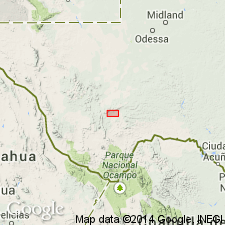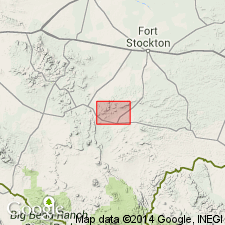
- Usage in publication:
-
- Road Canyon Member*
- Modifications:
-
- Named
- Dominant lithology:
-
- Limestone
- Shale
- AAPG geologic province:
-
- Permian basin
Summary:
Named as the basal member of the Word Formation for Road Canyon (though it is not exposed in the canyon). Type section designated and measured on southeast face of spur one-half mi southeast of Peak 5779, 2.4 mi due north of Skinner Ranch, Altuda 15 min quad, Brewster Co, TX in the Permian basin. Is 228 ft thick at type where it consists of (ascending): coarse conglomerate; fine-grained, massive, to blocky limestone; yellow platy shale; coarse, massive, granular limestone with cherty bryozoa, cup corals, and other fossils; yellow platy shale; gray, thick-bedded limestone with several bioherms; thin-bedded limestone; yellow cherty shale. Is variable lithologically. Some of the limestone is black and bituminous locally. Was called "First limestone member" of Word Formation in earlier reports. Thickness ranges from 100 to more than 300 ft. Extends from Old Word Ranch southwest along east branch of Hess Canyon as far as the east end of Lenox Hills. Cross section. Has scattered bioherms at base, crinoids, fusulinids, and ammonoids. Overlies Cathedral Mountain Formation (new). Underlies unnamed part of Word. Assigned to the Guadalupian, Early Permian.
Source: GNU records (USGS DDS-6; Denver GNULEX).

- Usage in publication:
-
- Road Canyon Formation*
- Modifications:
-
- Revised
- Age modified
- AAPG geologic province:
-
- Permian basin
Summary:
Road Canyon revised--removed from Word Formation (revised) and rank raised to Formation. Road Canyon is transferred from the Guadalupe to the Leonard Series of the Permian. The brachiopods of Road Canyon clearly are more closely related to those of the Leonard Series than those of the Word. The ammonoid fauna is well known (Miles, Furnish, 1940), and the presence of the genus PERRINITES in Road Canyon is offered as additional evidence for a Leonard age. Overlies Cathedral Mountain Formation; underlies Word Formation. Report area is the Glass Mountains, Brewster Co, TX in Permian basin.
Source: GNU records (USGS DDS-6; Denver GNULEX).

- Usage in publication:
-
- Road Canyon Formation*
- Modifications:
-
- Overview
- AAPG geologic province:
-
- Permian basin
Summary:
Measured 18 sections in Glass Mountains and northern Del Norte Mountains, Brewster Co, TX, Permian basin. Rocks represent maximum of four apparent transgressive depositional cycles representing carbonate shedding from a shoal developed on geanticline between Delaware basin and Marathon foreland basin with Road Canyon being deposited in foreland basin. Based on fossils, Road Canyon has been placed by workers in both Guadalupian and Leonardian (Permian); fusulinids show Cathedral Mountain affinities in cycle 1 and change to Wordian (lower Guadalupian) affinities in cycle 2; ammonoids mostly indicate Leonardian affinities but forms with Wordian affinity occur; and brachiopods show general Leonardian affinities. A sharp, major changeover of conodonts from MESOGONDOLELLA IDAHOENSIS to MESOGONDOLELLA NANKINGENSIS occurs at base or within lower part of cycle 2; changeover found throughout the world and represents a correlatable horizon. Grant and Wardlaw (1984, 27th Inter. Geol. Cong., Abs., v.1, p. 58) proposed that conodont changeover within Road Canyon provides marker for definition of base of Guadalupian. Overlies Cathedral Mountain Formation; underlies Word Formation.
Source: GNU records (USGS DDS-6; Denver GNULEX).
For more information, please contact Nancy Stamm, Geologic Names Committee Secretary.
Asterisk (*) indicates published by U.S. Geological Survey authors.
"No current usage" (†) implies that a name has been abandoned or has fallen into disuse. Former usage and, if known, replacement name given in parentheses ( ).
Slash (/) indicates name conflicts with nomenclatural guidelines (CSN, 1933; ACSN, 1961, 1970; NACSN, 1983, 2005, 2021). May be explained within brackets ([ ]).

